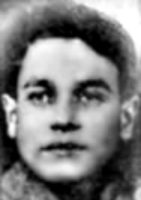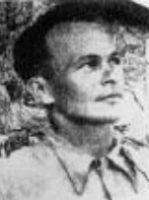 |
| Glik |
 |
| Kaczerginski |
On
1 May 1943, a group of Jewish writers and poets met in the
Vilnius Ghetto for an evening devoted to
"Spring in Yiddish literature". The
Warsaw Ghetto Uprising was still raging and
the meeting was filled with the spirit of the ongoing battle. At the meeting, the poet
Shmaryahu Kaczerginski met his fellow poet Hirsh Glik, and was informed that
Glik had written a new poem. They met the next morning.
"
Now listen carefully, I'll sing it for you,” Glik said.
Kaczerginski recalled:
"
He began to sing it softly, but full of excitement. His eyes glowed with
little sparks. The hour for which we yearned will come anew. Where did he get his faith? His
voice became firmer. He tapped out the rhythm with his foot, as if he was marching.”
The song that Hirsh Glik sang that
May morning -
“
Zog Nit Keynmol“ - was to spread with amazing
speed throughout the ghettos and camps, becoming a symbol of hope and defiance. Quickly adopted
by Jewish partisans, it is sometimes known as “Song of the Partisans”, inspiring Jews to fight if they
could, but if they could not fight, at least to survive.
After the war, the song was taken up by Jewish communities around the world, where it has
been sung as a memorial to Jews martyred during the
Shoah, even being included by
some families in their
Seder night Passover service.
Hirsh Glik was born in
1922 in
Vilnius
into a poor family; his father was a used clothes dealer. Acknowledged as an outstanding young author,
he began to write poems in Hebrew when he was only thirteen, later writing mainly in Yiddish. Because
of his family’s poverty he was forced to end his studies prematurely and become an apprentice in a
paper business, later working in a hardware store.
Following the occupation of
Vilnius by the Germans on
26 June 1941, Glik and his father were among those Jews
arbitrarily seized and sent to work in the peat bogs at
Biala-Waka and
Rzesza.
Even in captivity, Glik continued to write.
In
early 1943 the
Biala-Waka
camp was liquidated and Glik was sent to the
Vilnius Ghetto,
where he joined the United Partisan Organization (
Fareynegte Partizaner Organitzatsye – FPO)
and continued with his writing.
Among the songs he wrote was
"
Shtil, Di Nacht Iz Oysgeshternt", which recounted the heroic deeds
of
Vitka Kempner, a female resistance fighter,
who together with two companions,
Itzik Matskevitsch and
Moyshe Brause, blew up a German military transport carrying 200 German
soldiers on the outskirts of
Vilnius in
1942,
the first successful diversionary act of sabotage by the Jewish partisans of
Vilnius.
Abba Kovner recorded:
“
Lithuanians did not do it, nor Poles, nor Russians. A Jewish woman
did it, a woman who, after she did this, had no base to return to. She had to walk three
days and nights with wounded legs and feet. She had to go back to the ghetto. Were she
to have been captured, the whole ghetto might have been held responsible."
It was to be the first of many acts of resistance in which
Vitka Kempner
was to be involved.
On
1 September 1943, the FPO unit to which Glik belonged
was captured and he was deported to Estonia, initially to the camp at
Narva, subsequently to that
at
Goldfilz.
Even in the camps Glik continued to create, reciting his poems to his fellow prisoners who
memorized them and passed them on. Some written copies of his poems were buried in the
Vilnius Ghetto, but the great majority of his works are presumed lost.
In
summer 1944, together with eight other FPO men, Glik escaped from
Goldfilz. The advancing Soviet Army was in the region and the
intention was to join the local partisans. But Glik and all of his companions disappeared, probably
captured and executed by German soldiers in the area.
During the years of Nazi persecution, Glik had deliberately composed poems that were intended
to be sung - to raise morale, to encourage the partisans and to strengthen the Jews’ faith and hope
in the future. His most famous song “
Zog Nit Keynmol” based on a melody by two Soviet
Jewish composers,
Dimitri and Daniel Pokras,
has been translated into many different languages and remains a lasting monument to the triumph
of the human spirit, a beacon to illuminate a world of darkness.
Sources:
Gutman, Israel, ed.
Encyclopedia of the Holocaust, Macmillan Publishing Company, New York, 1990
Gilbert, Martin.
The Holocaust – The Jewish Tragedy, William Collins Sons & Co. Limited, London, 1986
http://www.leonarda.com/
http://www.stolaf.edu/
© ARC 2006






